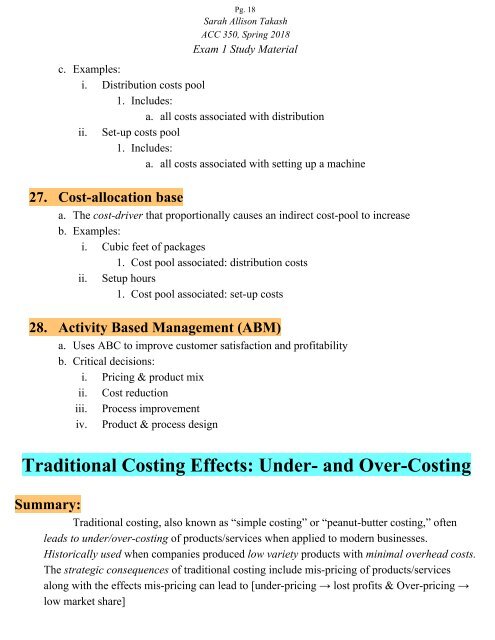(WIP) ACC 350 Exam 1 Study Material
Work in Process
Work in Process
Create successful ePaper yourself
Turn your PDF publications into a flip-book with our unique Google optimized e-Paper software.
Pg. 18<br />
Sarah Allison Takash<br />
<strong>ACC</strong> <strong>350</strong>, Spring 2018<br />
<strong>Exam</strong> 1 <strong>Study</strong> <strong>Material</strong><br />
c. <strong>Exam</strong>ples:<br />
i. Distribution costs pool<br />
1. Includes:<br />
a. all costs associated with distribution<br />
ii. Set-up costs pool<br />
1. Includes:<br />
a. all costs associated with setting up a machine<br />
27. Cost-allocation base<br />
a. The cost-driver that proportionally causes an indirect cost-pool to increase<br />
b. <strong>Exam</strong>ples:<br />
i. Cubic feet of packages<br />
1. Cost pool associated: distribution costs<br />
ii. Setup hours<br />
1. Cost pool associated: set-up costs<br />
28. Activity Based Management (ABM)<br />
a. Uses ABC to improve customer satisfaction and profitability<br />
b. Critical decisions:<br />
i. Pricing & product mix<br />
ii. Cost reduction<br />
iii. Process improvement<br />
iv. Product & process design<br />
Traditional Costing Effects: Under- and Over-Costing<br />
Summary:<br />
Traditional costing, also known as “simple costing” or “peanut-butter costing,” often<br />
leads to under/over-costing of products/services when applied to modern businesses.<br />
Historically used when companies produced low variety products with minimal overhead costs.<br />
The strategic consequences of traditional costing include mis-pricing of products/services<br />
along with the effects mis-pricing can lead to [under-pricing → lost profits & Over-pricing →<br />
low market share]


